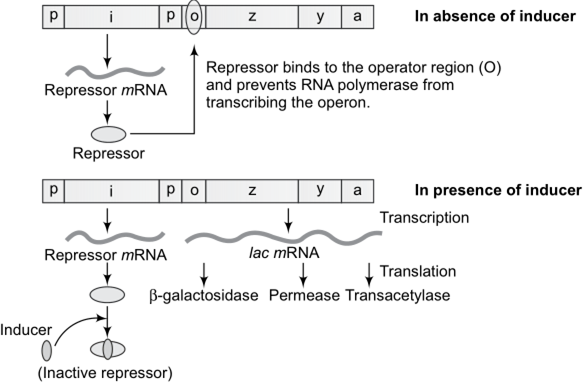 Short Answer Type
Short Answer TypeThe base sequence in one of the strands of DNA is TAGCATGAT.
(i) Give the base sequence of its complementary strand.
(ii) How are these base pairs held together in a DNA molecule?
(iii) Explain the base complementarity rules. Name the scientist who framed this rule.
 Long Answer Type
Long Answer TypeDescribe how the lac operon operates, both in the presence and absence of an inducer in E.coli.
The lac operon consists of one regulatory gene (the i gene) and three structural genes (z, y, and a).
The i gene codes for the repressor of the lac operon.
The z gene codes for beta-galactosidase (β-gal), which is primarily responsible for the hydrolysis of the disaccharide, lactose into its monomeric units, galactose and glucose.
The y gene codes for permease, which increases permeability of the cell to β-galactosides. The a gene encodes a transacetylase.
Hence, all the three gene products in lac operon are required for metabolism of lactose.
Lactose is the substrate (inducer) for the enzyme beta-galactosidase and it regulates switching on and off of the operon.
The repressor of the operon is synthesised all-the-time or constitutively from the i gene.
The repressor protein binds to the operator region of the operon and prevents RNA polymerase from transcribing the operon.
In the absence of inducer the the repressor is active and the RNA polymerase cannot access the promoter region and hence the transcription does not take place.
In the presence of an inducer, such as lactose or allolactose, the repressor is inactivated by interaction with the inducer. This allows RNA polymerase access to the promoter and transcription proceeds.

 Short Answer Type
Short Answer Type(a) Draw a neat labelled diagram of a nucleosome.
(b) Mention what enables histones to acquire a positive charge. Long Answer Type
Long Answer TypeDescribe Frederick Griffith’s experiment on Streptococcus pneumonia. Discuss the conclusion he arrived at.
 Short Answer Type
Short Answer TypeFollowing are the features of genetic codes. What does each one indicate ? [2]
Stop codon; Unambiguous codon; Degenerate codon; Universal codon.
